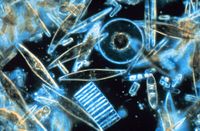
Photo from wikipedia
This paper reports the development of biofilms on stainless steels (SS) upon exposure in a natural freshwater ecosystem for about six months and focuses on the composition of diatom populations.… Click to show full abstract
This paper reports the development of biofilms on stainless steels (SS) upon exposure in a natural freshwater ecosystem for about six months and focuses on the composition of diatom populations. By using environmental scanning electron microscopy (ESEM) technique, we provide a detailed description regarding diatom identification at species level as well as their main characteristics, including type, morphology, ability to form colony, and motility. Results reveal the presence of both prostrate (initial colonizers) and stalked (late colonizers) forms. Pennate diatoms, Cocconeis placentula and Amphora coffeaeformis, and a centric diatom, Melosira varians, are shown to be the abundant forms regardless of the SS type. Pennate diatoms dominate the community and are directly attached to the substratum, whereas the centric form is entangled in the biofilm matrix in a significant number. The dominance of adnate forms suggests that these cells are sturdy and successfully maintaining their population. In situ monitoring of the electrochemical response of immersed materials showed ennoblement of the open circuit potential, which seems to be due to the biogenic production of H2O2, detected in a significant amount within the biofilms. The substantial enrichment of biofilms with diatoms potentially suggests the implication of these microorganisms in the process of ennoblement. A mechanism is proposed in this paper describing the possible interactions of diatom community with SS in the studied ecosystem.
Journal Title: Scanning
Year Published: 2017
Link to full text (if available)
Share on Social Media: Sign Up to like & get
recommendations!